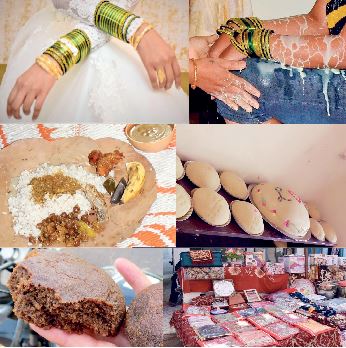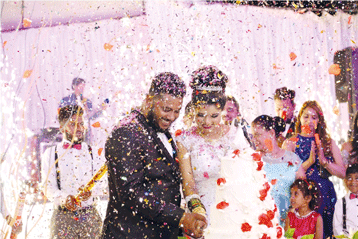When it come to Goan Catholic weddings there are numerous traditions and customs that are followed. Yet the Goan wedding is a package of fun, laughter and entertainment. Over the years the traditions, styles, ethics and customs of a Goan wedding are slowly fading away
Among the unique traditions of Goan weddings is the bikrachi jevon – when the poor and not so well off of the village community, are invited for a sumptuous meal for lunch or dinner by the family in which a marriage is taking place. However, today the occasion is just an opportunity for large families to get together. In Hindu marriages a cloth is held between the bride and groom by way of a traditional custom. It is solemnly removed when the mangalsutra is placed around the bride’s neck. This tradition has its origins in marriages customs of the Maratha people.
CULTURE and tradition run deep in Goan blood. Goan weddings aren’t just a day’s celebration, they are spread over four to five days. Goans definitely take every celebration, especially weddings, very seriously. Plans are made at least a year in advance, and it goes without saying that a lot of money is spent on all the events involved. Of all the various wedding venues in India one could choose, nothing beats Goa.
October through February witness a number of weddings in Goa. Being cooler months the weather is perfect for an outdoor wedding celebrations. For those on a budget a thrifty wedding is also possible thanks to a number of indoor air-conditioned halls as well.
There are quite a few events leading up to a traditional Goan wedding. Though not all of them are always followed, many couples try to opt for a completely traditional experience. Let’s take a look at all the celebrations right from the first to the last day, in detail.
The first tradition that is a must for a Goan wedding is chuddo
In the Goan wedding culture, bangles are an important bridal accessory. It is a custom where the Goan bride has to wear the best bangles possible. These bangles are of a particular colour and design and are called “chuddo.” They are usually purchased from the regular/local bangle-seller of the village, known as the volar or kankonkar, who is often invited home to do the fitting. The bangles are made of glass and very delicate. The chuddo ceremony is usually performed at the house of the maternal uncle of the bride. These bangles represent married life and hence, if her husband passes away or dies the married woman breaks her bangles over the coffin and the broken pieces are thrown in. The number and colour of the chuddo bangles differ from village to village.
The chuddo ceremony itself sees the special bangles being fitted onto the wrists of the bride-to-be by the volar. Relatives who participate take the opportunity to get some bangles for themselves as well. The family offers money as a token of blessing and is this is kept in a tray placed near the bangle-seller. The chuddo ceremony is common to both the Hindus and Christians of Goa.
In addition, the bride receives gifts from relatives and wears the ceremonial bangles, eight to nine in number on her right wrist and seven to eight on her left. The chuddo ceremony signals the start of a young woman’s start to a married life.
The ceremony is held at the bride’s maternal uncle’s house and few relatives and village community women are invited to get fitted with bangles for themselves too. The bride’s family offers money, rice and coconut to the bangle maker or “kakonnkar.” During this ceremony melodious Goan-songs/mandos are sung by the people gathered which are referred to as “zoti.”
The second tradition is a ritual called ros
THIS is the anointing ceremony where both bride and groom are anointed with coconut milk by their parents, relatives, neighbours and friends in their respective houses. This is usually done two to three days prior to the wedding. This ceremony symbolizes the beginning of new life. Coconut milk is used and is said to cleanse or purify the couple before the wedding, this ceremony also signifies the end of their single lives.
The ones anointing the couple have a lot of fun as they get to break eggs on the couple’s head and throw coins or cash into the milk bowls which are later given to the maids or family members helping in the wedding preparations. Needless to say the ros can get rather messy, but it’s a lot of fun for all those involved. Why it is usually the event that is looked forward to the most.
BHUIM JEVON
THIS is a meal in honour of the family’s ancestors and deceased and is also called bikaraimche jevon. This meal is primarily for the poor people and beggars in the locality and those from orphanages and old age homes in the village. The tradition is not carried out after a dear one has departed his or her mortal life but some Goans insist on observing the tradition. The families involved just prepare a large quantity of simple home food and go around offering or distributing the food, or invite people to the village for a sit-down feast in the open. This food for the poor served during marriages and deaths in a family is primarily to seek blessings for family members and relatives.
“Bhuim jevonn” or “bhikrea jevonn” could also be a practice wherein the bride’s and groom’s family in their respective homes serve a meal to their relatives and in this way practically the entire village is invited for the feast. There is a lot of thanksgiving and showing of gratitude to the dead ancestors of the family. Bhikrea jevonn comprises of the Goan traditional food also referred to as “von-xit.” There will be polished rice, dried prawn curry, and undoubtedly some fried fish too. The “von” or “godshem” is a Goan sweet dish or dessert served after lunch.
Opsun divnchem or Oopsun
THIS is a tradition where the bride is formally given away by the father or the guardian of the bride to the groom.
Dennem
ALSO known as dowry or trousseau. In this Goan wedding tradition the bride’s family offers household essentials that might be useful to the bride after marriage. It includes everything from jewellery to clothes ot furniture and kitchenware too. It is essential to see a little image or statue of baby Jesus within the trousseau. This is to ensure that bride doesn’t invite any bad luck as she starts her new married life.

Saddo
A SADDO may be a red dress given to the bride by the groom’s family or her circle of relatives. After the church nuptials, the bride is introduced and welcomed to her new home wherein the groom’s parents places this “saddo” on the bride’s shoulder. Whereas, the bride’s family gives an identical dress to the bride on the second day of the marriage when the bride goes to her home.
Xim
THIS Goan wedding tradition is mostly done after the wedding. The xim basically means a boundary that’s marked by pouring liquor. And on either side of this boundary, the bride and thereafter the groom’s family, will stand and offer prayers, recite holy verses and shower blessings on the couple. Also, to finish all disagreements between the families if there any and everyone goes home happy.
Vojje
VOJJE is made up of a few sweetmeats prepared by the bride’s family at the groom’s house to distribute amongst family, relatives, and villagers. Some of it is later returned back to the bride’s family. The vojje includes the Goan sweet bol, doce and bananas. Vojje sweets are also distributed to the village and families by way of saying thank-you for support and blessings for the marriage.
After the wedding ceremony there is the appoune or porthopon. In this tradition the bride’s family invites the groom’s family over to their house usually the day after the wedding ceremony or reception. The bride wears a bright red saree or dress called saddo and a huge feast is prepared. Both the families get a chance to mingle in a more casual and relaxed setting while getting to know each other better.
So you see getting married is not as simple as it may sound nowadays. There is a lot to getting married in the old traditional ways which remain close to the hearts of many Goans. There are many wedding customs that take place in the span of four to five days. It may be a small Goan wedding but traditions are critical because they have a lot of emotional and sentimental meaning associated with them. The Goan wedding traditions are carried out with the whole family from both the bride’s side as well as the groom’s side, making it a family affair and strengthening the familial ties. No wonder from start to finish most Goans enjoy every bit of a family wedding – the big fat Goan wedding is really quite something to remember with warmth as the years go by and the family tree grows with additional family members!
From start to finish Goans love to enjoy their big fat one of a kind weddings!
Courtesy: Its Goa
